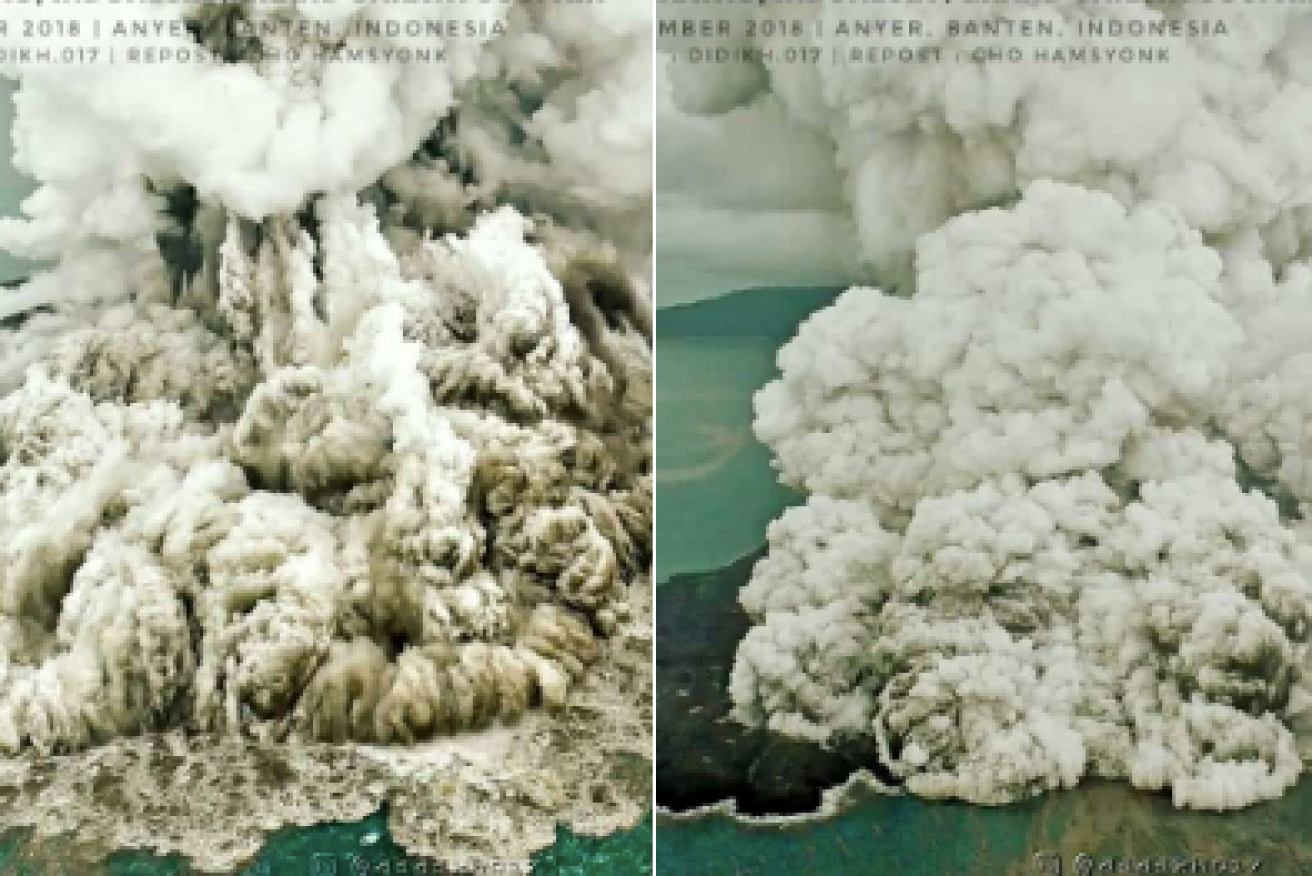Tsunami death toll nears 430 as rain hampers search


Images taken on Sunday showing magma flowing into the sea.
Rain was hampering emergency authorities as they entered their fourth day of searching for 154 people still missing after a tsunami hit the Sunda Strait in Indonesia.
According to the latest official figures, which authorities say could increase, the death toll has reached at least 429, with more than 1500 injured and some 16,000 displaced.
On a day the country commemorates the anniversary of the 2004 Boxing Day tsunami that killed about 230,000 people (167,799 in Indonesia), rescuers are searching the ruins of collapsed buildings, vehicles and thick vegetation.
Indonesian military and rescue teams are still working along the coastline, hoping to find survivors of the tsunami that was triggered by a sub-marine landslide from a volcano between Java and Sumatra, about 9pm on Saturday.
Kondisi Gunung Anak Krakatau yang divideokan dari KRI Teluk Cirebon 543 pads 26/12/2018, 16.33 WIB. Erupsi masih berlangsung. Tipe erupsi Gunung Anak Krakatau strombolian yang mengeluarkan abu vulkanik dan lontaran batu pijar terus menerus. Status Waspada (level 2). pic.twitter.com/ESydS9UCTc
— Sutopo Purwo Nugroho (@Sutopo_PN) December 26, 2018
Early on Christmas Day, the death toll from the disaster had reached at least 373 people, with thousands more injured. Within hours another 50 bodies had been recovered, with hoping fading that any further survivors will be found.
Thick clouds of ash spewed from Anak Krakatau, a volcanic island where a crater collapse at high tide late on Saturday set off waves that smashed into coastal areas on both sides of the Sunda Strait between the islands of Sumatra and Java.
The operation continued as new photos emerged of the aftermath of the eruption.
The images, posted to Twitter by National disaster agency spokesman Sutopo Purwo Nugroho, were taken on Sunday and show magma flowing into the sea and a large ash cloud from Anak Krakatoa volcano.

The images taken on Sunday, hours after the eruption. Photo: Twitter
Rescuers used heavy machinery and bare hands to dig bodies out of mud and wreckage along a 100-kilometre stretch of Java’s west coast.
More than 1400 people were injured, and about 12,000 residents have moved to higher ground, with a high-tide warning extended to Wednesday.
The vast archipelago, which sits on the Pacific “Ring of Fire”, has suffered its worst annual death toll from disasters in more than a decade.
Erupsi Gunung Anak Krakatau yang terpantau dari pesawat Grand Caravan Susi Air pada 23/12/2018. Hampir setiap hari Gunung Anak Krakatau erupsi sejak Juni 2018. Erupsinya tidak besar. Status Waspada (level 2). Zona berbahaya di dalam radius 2 km. Jalur pelayaran di aman. pic.twitter.com/w5zkXPqdyh
— Sutopo Purwo Nugroho (@Sutopo_PN) December 24, 2018
Earthquakes flattened parts of the island of Lombok in July and August, and a double quake and tsunami killed more than 2000 people on a remote part of Sulawesi island in September.
“At least 373 people have died, while 128 people are currently missing,” Mr Nugroho said Monday evening (local time).
Saturday’s tsunami destroyed more than 700 buildings, from small shops and houses to villas and hotels. It took just 24 minutes after the landslide for waves to hit land, and there was no early warning for those living on the coast.
Kondisi bangunan yang banyak rusak akibat terjangan tsunami di daerah Sumur Kabupaten Pandeglang. Petugas dan kendaraan evakuasi sudah bisa menembus daerah Sumur. Sebelumnya beberapa jalan dan jembatan rusak. Alat berat dikerahkan untuk membantu evakuasi korban. pic.twitter.com/ZL55sh3DXL
— Sutopo Purwo Nugroho (@Sutopo_PN) December 24, 2018
Out in the strait, Anak Krakatau (Child of Krakatau) was still erupting on Sunday night, belching white smoke and ash into the sky.
The meteorology agency reported that an area of about 64 hectares of the volcanic island had collapsed into the sea.
In 1883, the volcano – then known as Krakatoa – erupted in one of the biggest blasts in recorded history, killing more than 36,000 people in a series of tsunami, and lowering the global surface temperature by 1 degree Celsius with its ash. Anak Krakatau is the island that emerged from the area in 1927, and has been growing ever since.
The high waves isolated hundreds of people on Sebesi island, about 12 kilometres from the volcano.
President Joko Widodo, who is running for re-election in April, told disaster agencies to install early warning systems, but experts said that, unlike with tsunami caused by earthquakes, little could have been done to alert people that waves were coming.

Indonesian President Joko Widodo surveys the damage caused by the tsunami. Photo: Getty
Excavators were being used to move debris including piles of steel roofing tangled like spaghetti. Medics were sent in with the military, while groups of police and soldiers reached remote areas.
One team used sniffer dogs to search for survivors at the beach club where a tsunami washed away an outdoor stage where the Indonesian rock band Seventeen were performing at a party for about 200 guests. They had already pulled out nine bodies that day.
At a village 20 kilometres away, district chief Atmadja Suhara said he was helping to care for 4000 refugees, many of them now homeless.
“Everybody is still in a state of panic,” he said. “We often have disasters, but not as bad as this.”
-with AAP








